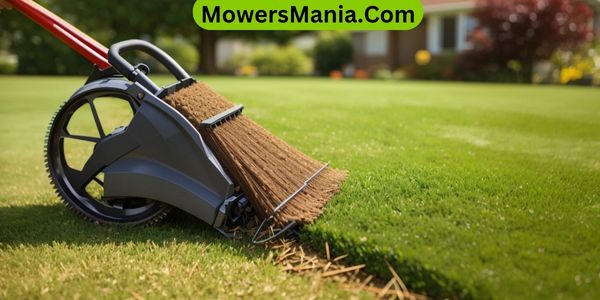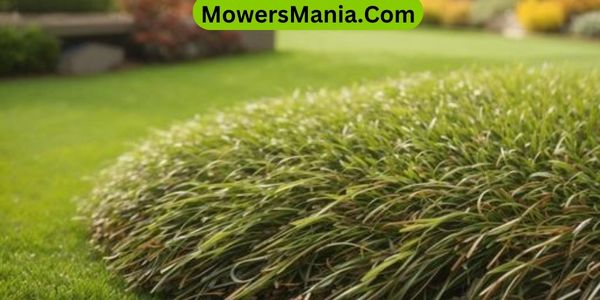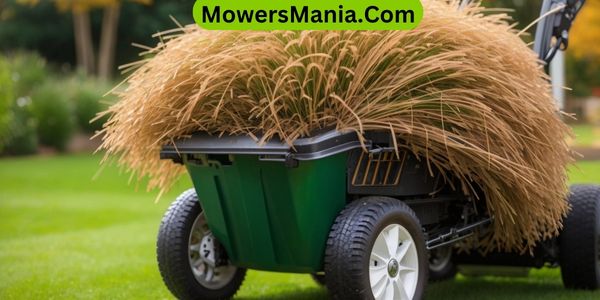Are you looking for a way to ensure a healthier, greener lawn come Winter? Look no further than dethatching!
By removing the layer of dead grass and debris that accumulates over time, you can give your lawn a breath of fresh air. This process increases oxygen flow to the grass roots, improves water absorption, and enhances nutrient uptake.

Say goodbye to disease and pests while promoting a thicker, lusher lawn. Get ready to enjoy the benefits of dethatching this winter!
Increased Oxygen Flow to Grass Roots
To enhance the health of your lawn’s grass roots, it’s essential to increase the oxygen flow by dethatching it before winter.
Dethatching refers to the process of removing dead grass, debris, and built-up thatch from the surface of your lawn. Thatch is a layer of dead grass stems, roots, and other organic matter that accumulates over time.
If left unchecked, excessive thatch can create a barrier, preventing oxygen and nutrients from reaching the grass roots. By dethatching your lawn, you’re effectively breaking up this barrier and allowing for better air circulation.
When oxygen flow is increased, the grass roots receive the necessary nutrients and energy to thrive. This results in a healthier and more resilient lawn, better able to withstand the harsh conditions of winter.
In addition, dethatching also helps prevent the growth of moss and weeds, as they thrive in environments with poor air circulation. By removing the thatch, you’re creating an environment that’s less favorable for these unwanted plants.
To dethatch your lawn, you can use a dethatching rake or a power dethatcher. The rake method involves manually raking the lawn to remove the thatch, while the power dethatcher uses rotating blades to mechanically remove the thatch. Whichever method you choose, it’s important to be thorough but gentle to avoid damaging the grass roots.
Improved Water Penetration and Absorption
Improve your lawn’s water penetration and absorption with dethatching. Dethatching is a crucial step in preparing your lawn for winter, as it helps water reach the roots more efficiently and ensures better absorption.
Here are some benefits of dethatching in terms of water penetration and absorption:
- Enhanced soil aeration: Thatch, a layer of dead grass and debris, can prevent water from reaching the soil and getting absorbed by the roots. By removing the thatch, you allow for better soil aeration, enabling water to penetrate deeper into the ground.
- Reduced runoff: When thatch builds up, water tends to pool on the surface and eventually runoff. This not only wastes water but also deprives your lawn of the moisture it needs. Dethatching helps prevent runoff by facilitating proper water penetration and absorption.
- Improved moisture retention: By dethatching your lawn, you create channels for water to flow directly to the roots, enabling them to absorb moisture more effectively. This helps your lawn stay hydrated for longer periods, even during dry spells.
- Prevention of disease and pests: Excess thatch can create a favorable environment for disease and pests to thrive. By dethatching, you reduce the risk of fungal growth and pest infestations, which can further improve your lawn’s water penetration and absorption.
Incorporating dethatching into your lawn care routine can greatly improve water penetration and absorption, ultimately leading to a healthier and more vibrant lawn.
Enhanced Nutrient Uptake for Healthier Grass

Dethatching your lawn in preparation for winter enhances nutrient uptake for healthier grass, allowing it to thrive during the colder months.
When thatch, a layer of dead grass, roots, and debris, builds up on your lawn, it can prevent essential nutrients from reaching the soil and being absorbed by the grass roots.
By dethatching your lawn, you remove this barrier and create an optimal environment for nutrient uptake.
Thatch acts as a barrier, preventing nutrients from reaching the soil. When nutrients are unable to penetrate the thatch layer, they remain on the surface and are unable to benefit the grass.
Dethatching breaks up this layer, allowing nutrients to reach the soil and be absorbed by the grass roots. This enhanced nutrient uptake provides the grass with the essential elements it needs to stay healthy and strong throughout the winter.
In addition to improving nutrient uptake, dethatching can also help prevent nutrient runoff. When excess thatch builds up, it can create a water-resistant barrier that causes nutrients to wash away during heavy rain or irrigation.
By removing the thatch layer, you reduce the risk of nutrient runoff and ensure that the grass receives the maximum benefit from the nutrients applied to the soil.
Reduced Risk of Disease and Pest Infestation
Maintaining a dethatched lawn reduces the risk of disease and pest infestation, ensuring a healthier environment for your grass during the winter months.
By removing the layer of dead grass and debris, you create an inhospitable environment for pests and diseases to thrive.
Here are some ways in which dethatching can help protect your lawn:
- Improved Air Circulation: Dethatching allows for better air circulation, preventing the buildup of moisture that can attract pests and create favorable conditions for diseases.
- Enhanced Drainage: Thatch can trap water, leading to excessive moisture that attracts pests like mosquitoes and promotes fungal diseases. Dethatching promotes proper drainage, reducing the risk of waterlogged soil.
- Increased Sunlight Exposure: Thatch can block sunlight from reaching the grass, hindering its growth and making it more susceptible to diseases. Removing thatch allows sunlight to penetrate the soil and promote a healthier lawn.
- Easier Pest Detection: Without a layer of thatch, it becomes easier to spot signs of pest infestation and take timely action to prevent further damage.
Promotes Thicker, Greener Lawn in the Winter

With a dethatched lawn, you can expect a thicker and greener yard come Wintertime. Dethatching removes the layer of dead grass, roots, and debris known as thatch, which can prevent water, air, and nutrients from reaching the soil. By eliminating this barrier, your lawn can flourish and thrive.
When Winter arrives, your dethatched lawn will have a better chance to absorb the sunlight it needs to fuel photosynthesis, resulting in healthier grass growth.
With improved access to essential resources, your lawn will be able to produce more robust and stronger roots, leading to a thicker turf. This increased density not only provides a more visually appealing lawn but also helps to crowd out weeds and prevent their growth.
Additionally, dethatching allows for better water penetration, reducing the risk of water pooling or runoff. As a result, the grass will receive the proper hydration it needs to maintain its lush green color throughout the Winter and summer months.
Frequently Asked Questions [FAQs]
How Often Should I Dethatch My Lawn in Preparation for Winter?
You should dethatch your lawn in preparation for winter every year. This helps remove dead grass and debris, allowing your lawn to breathe and absorb nutrients more effectively, resulting in a healthier and greener lawn.
Can Dethatching Damage My Grass Roots?
Dethatching can damage your grass roots if done improperly or too aggressively. However, when done correctly, it helps promote healthy growth by removing dead grass and allowing better access to nutrients and water.
Is There a Specific Time of Year When Dethatching Is Most Effective?
There’s no specific time of year when dethatching is most effective. It depends on your lawn’s condition. Regular dethatching can prevent thatch buildup and promote healthy grass growth. Consult a professional for guidance.
What Tools or Equipment Do I Need to Dethatch My Lawn?
To dethatch your lawn, you’ll need a dethatching rake or a power dethatcher. These tools help remove the layer of dead grass and debris, allowing for better air and water circulation.
Are There Any Alternative Methods to Dethatching That Can Achieve Similar Results?
There are alternative methods to dethatching that can achieve similar results. You can try using a lawn aerator or a power rake to effectively remove thatch buildup and prepare your lawn for winter.
Conclusion
In conclusion, dethatching your lawn before winter brings numerous benefits. It allows increased oxygen flow to the grass roots, improved water penetration and absorption, and enhanced nutrient uptake for healthier grass.
Additionally, it reduces the risk of disease and pest infestation, resulting in a thicker and greener lawn come Wintertime.
So, make sure to include dethatching in your winter lawn care routine for a vibrant and thriving lawn next year.



